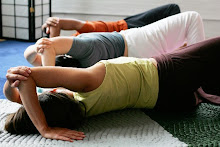Fun fact: did you know that Amazon.com lists 746,365 books with the keyword "food;" and 600,696 with the keyword "exercise?" That's a pretty good indicator that people are interested in those two topics. Leave it to our modern age to take two basic, foundational aspects of life and health, and complicate them to the point of confusion and controversy.
Food is a sensitive subject, and with good reason, since our national statistics for obesity and the health problems related to it are alarming. Michael Pollan has identified the "American paradox:" it seems that the more we worry about nutrition, the less healthy we become. In our Western diet, food has been replaced by "nutrients," edible food-like substances, some touting a health benefit on the pretty package. Sometime during the mid-20th century, food left our grandmother's kitchens and found its way, in the name of progress, to the lab. Healthy, wholesome, nutritious foods were analyzed and broken down into their chemical components, then processed and packaged. This reductionist approach (to reduce something to its individual constituents, the sum of the parts) has made us fat and completely irrational about food.
A similar irrationality persists around the topic of our bodies, specifically our anatomy and how to move it and use it. Since most people no longer do physical labor or farm chores, we now “work out,” something that wasn’t necessary 50 years ago. If you are tossing hay bales, or hanging laundry, or painting the front porch, you’re thinking about how to get the job done, not whether your hamstrings are tight or your subscapularis is impinged. Children and adults used to play outside. A game of catch before dinner, riding bikes after school because it was fun and transportation, and the leisurely walk after dinner to see the neighbors, have all been replaced by simulated activities performed on equipment. Just like eating food-like substances with nutrients but no nutritional value, we perform movement-like actions that have no functional relevance. Who has to walk up stairs for 45 minutes in the real world, or dead-lift weight equivalent to a refrigerator?
The experts, to whom we have entrusted our bodies, have taught us not to trust our sensations. A feeling of pleasure means you’re not working hard enough. “No pain, no gain” rules. We dissect ourselves and each movement, being careful to execute perfect form while maintaining the illusion that we control the individual firing of each muscle fiber. The body is the enemy, and it must be punished, pummeled, stretched, exhausted, and shown who is boss. We learn to strain, to push, and to congratulate ourselves for surviving a “brutal” workout. Small wonder that back pain and exercise-related injuries are at an all-time high. And yet, people seem unwilling to hear any suggestion that our attitude toward exercise is unhealthy.
Michael Pollan has a simple solution to food insanity. Eat food. Not too much. Mostly plants. Moshe Feldenkrais devised an ingenious process to restore sense and sensibility to our actions and our way of being in physical experience. Move. Think. Sense. Feel. Feldenkrais’ work restores the image of a healthy functional system, involving the whole self in every action. The pleasures and benefits of food and exercise are only available when we remember that the whole is greater than the sum of the parts.


![Reblog this post [with Zemanta]](http://img.zemanta.com/reblog_e.png?x-id=3ae9d042-2c34-40f5-a0b0-a12ddb9d6332)


No comments:
Post a Comment